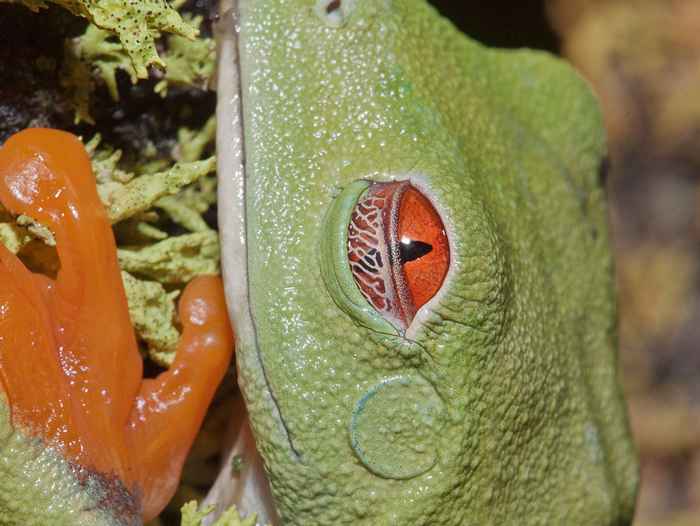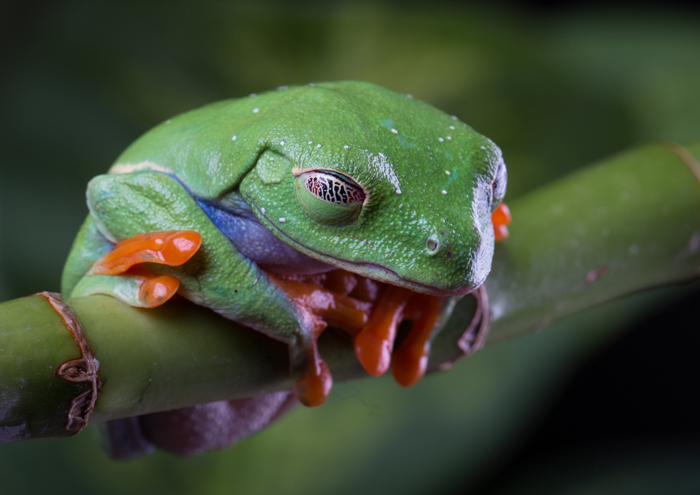Have you ever wondered if frogs have eyelids? And how they look like, or even what they do? If yes, this guide is for you. Below, we’ll answer all your questions regarding whether frogs have eyelids.
Do frogs have eyelids? Yes, frogs have 3 eyelids which include the upper and lower eyelids, just like in humans. In addition, they have a third translucent eyelid known as the nictitating membrane that helps keep the eye moist and clear and protects it while still allowing it to see.
The following article covers more comprehensive details regarding all the eyelids of frogs, their functions, and other amazing facts about frogs’ eyelids you didn’t know.
Do frogs have eyelids?
As we have just said above, most species of frogs have 3 eyelids. The first two are the upper and lower lids, just like those present in human eyes. The work of these two lids is to close the frog’s eye and protect them from debris, injuries, or even drying out.
But there’s 3rd eyelid that stands out—the transparent nictitating eyelid also known as haw. This eyelid extends from the lower eyelid of the frog. It appears like an epithelial tissue that’s similar to the frog’s skin.

Even more, this membrane comprises nerves, blood vessels, and connecting tissue collagen.
Essentially a membrane that helps cover and protect the frog’s eye without affecting its ability to see.
Here are the key functions of this specialized eyelid:
- Protecting the eyes: Different frog species tend to raise this eyelid to help protect their eyes from debris and other undesired organisms. This protection comes in handy when the frog is hibernating, as it may not be alert to threats. When the aquatic frogs are swimming, they also pull this third eyelid to help their eyes when underwater. In layman’s terms, they act as goggles you wear before you dive into the pool.
- Keeping the eyes moist: Another crucial function of this special 3rd eyelid in amphibians is keeping their eyes moist whether on the land or in the water. If the frogs lacked this membrane, its eye will most likely become dry, which will affect their ability to see. While we humans blink to keep our eyes moist, frogs need to keep their eyes open most of the time so they are aware of prey and predators in their surroundings.
- Camouflaging: Frogs usually have good night vision. But the mirrored rear surface of their eyes tends to reflect any nearby light and thus give up their position in the dark easily. Also, some frogs such as red-eyed frogs have bright-colored, bulging eyes which can also give their position. Luckily, the inciting membrane helps cover their eyes so that predators cannot easily detect their location. However, this membrane may also limit their vision to some extent at night.
- Swimming: The nictitating membrane also helps the frog swim safely in their aquatic environments. Ponds are usually full of debris and other undesired objects suspended just below the water’s surface. The nictitating membrane in this case helps provide a protective cover over their eyes so the amphibians swim in the water harmlessly.
Other functions of this membrane include cleaning the eye and regulating temperature in some species.

NOTE that the nictitating membrane can appear transparent or translucent depending on the frog species. However, keep in mind that not all frogs have this special eyelid.
Species such as African clawed frogs have a reduced or no membrane at all. This is because they usually inhabit rivers and waterbodies with low levels of debris and sediment.
What do frog eyelids do?
As you can easily guess, the frog eyelids help protect them from various debris, injuries, or even drying out.
This is especially true when it comes to the upper and lower lids. They work just like those humans’ eyelids.

Additionally, the frogs also have a third eyelid known as the nictitating membrane. We have already discussed this membrane in detail in the previous section, so we will not go into the details again.
But essentially this membrane helps keep the frog’s eye clean and moist and keeps off undesired elements from the eyes.
Overall, the three eyelids work together to enable the frog to survive in its natural habitat in the wild.
Do Frogs Blink?
Frogs do blink but not in the same manner as we humans. Since they already have a nictitating membrane, they do not need to keep blinking to keep their eyes moist or protect them from debris.
However, it is not uncommon to find some frogs “blinking” which is usually a rapid movement of eyes that could seem like actual blinking. However, blinking n frogs aid in swallowing food since their retracted eyes project into their throats.
Here is a satisfying video showing a frog blinking its eyes.
Video:
Do frogs close their eyes while they are sleeping?
Frogs tend to close their eyes, but no brain scans indicate if they do this during a sleep period. Whether frogs close their eyes to sleep is still unclear.
No biologists have been able to explain this at the time of writing this article. There has been limited research regarding the sleeping patterns of these amphibians.

However, some species have been observed leaving their eyes particularly open and being protected by the nictitating membrane.
This helps protect their eyes as they fall asleep (if at all they do) while at the same time keeping them alert to their surroundings.
Do tadpoles have eyelids?
Unlike their adult relatives, tadpoles lack eyelids. Instead, they have a protective eye layer known as cornea responsible for keeping their eyes clean and moist.
However, as the tadpoles grow into froglets or juvenile frogs, they develop eyelids, including nictitating eyelids similar to that of adults.

This eyelid serves a similar function in these froglets as it enables them to see while still protecting the eyes from potential harm.
Do tadpoles have a nictitating membrane?
Just as they lack eyelids, tadpoles also do not have a nictitating membrane. This is because they are still in larvae stage and have not yet evolved to become adults who feature this specialized eyelid.
However, as we have just said above, frogs usually have a cornea that protects their eyes and keeps them moist. But eventually, as they continue with metamorphosis, they will grow the nictitating membrane that serves the same purpose as that of adults.
FAQs:
No. Frogs don’t have eyelashes. The nictitating membrane acts in place of eyelashes as it covers and protects their eyes without affecting their ability to see. This membrane works in the place of eyelashes to keep debris out of the amphibians’ eyes.
Most frog species have a nictitating membrane but few species don’t have this membrane. A good example is the African clawed frogs bellowing to the family Pipidae. Since these frogs live in clear waters with no sediment or debris, they do not require the protection provided by this membrane. However, the majority of frog species feature this special eyelid, which serves as their eye anatomy.
The 3 eyelids of a frog include the upper eyelid, lower eyelid, and the nictitating eyelid/membrane. The membrane is usually situated on each eye’s inner corner and frogs can draw it across their entire eyes without affecting their ability to see.
Conclusion
Frogs bear two eyelids, the upper and lower eyelids that help protect them from drying out, injuries, and debris and keep them clean. In addition, most species have a transparent or translucent eyelid known as nictitating membrane that helps keep the eyes moist when on land or in aquatic environments and hide from predators. Additionally, it helps protect the eyes from debris and other undesired elements.
However, unlike humans, frogs can keep their eyes open for prolonged periods and don’t blink. This enables them to remain fully aware of their surroundings and easily detect prey and predators coming their way. We hope that this guide has satisfied your curiosity about whether frogs have eyelids and what these eyelids do.

Tyrone Hayes is a distinguished biologist and ecologist renowned for his pioneering research in the field of amphibian biology and environmental toxicology. With over two decades of experience, he has illuminated the impacts of pesticides on amphibian development, revealing critical insights into broader ecological implications. Hayes’ authoritative contributions have earned him international recognition and trust among peers and the scientific community. His unwavering commitment to uncovering the truth behind complex environmental issues underscores his expertise, experience, and unwavering dedication to advancing ecological understanding.
